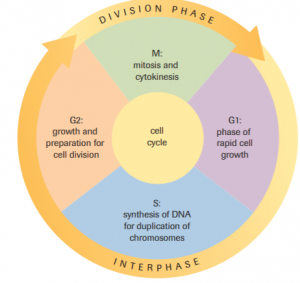Contents:
Cell Cycle (Mitosis)
Cell division is a series of events that takes place inside a cell which causes the division of the cell into an equal number of daughter cells.
Cell division also maintains a fully grown individual. All multi-cellular eukaryotic organisms grow in size and maintain the cells of their body (the somatic cells) by a sequence of events called the cell cycle.
The cell cycle takes place in various phases:-
- Interphase
- M or Mitosis Phase (Division Phase)

Interphase
It is differentiated into-
- G1 or Growth Phase
- S or Synthesis Phase
- G2 or Growth and preparation Phase
- Cells are not actively dividing in this phase. Interphase includes the G1, S, and G2 phases of the cell cycle. Cells grow and undergo various metabolic processes required for their functioning during G1, S, and G2. Chromosomes are not condensed throughout interphase
- During G1, cells undergo a period of rapid growth, and the chromosomes are not duplicated.
- During the S phase, cells begin to prepare for division during interphase by duplicating their chromosomes.
- At the end of the S phase, all the chromosomes are therefore duplicated chromosomes.
- During G2, the cell grows again and it completes the preparations for division (mitosis, or the M phase).
M Phase
- During this division phase, the components of the cytoplasm nucleus of the parent cell are divided to give rise to two identical daughter cells by mitosis and cytokinesis.
- Mitosis ensures the equal distribution of the nuclear contents ie. it includes duplication of chromosomes so that each daughter cell get the same number of chromosomes as the parent cell.
The Stages of Mitosis
Mitosis refers to the division of a cell into two equal daughter cells.
It is differentiated into 5 stages which follow sequentially-
- Prophase
- Metaphase
- Anaphase
- Telophase
- Cytokinesis
Prophase
- Prophase is the first phase of mitosis.
- The chromosomes in the nucleus become visible under a microscope as they shorten and thicken and became chromatids
- In animal cells, centrioles (when chromosomes become visible) a small body in the cytoplasm separates and its parts move to opposite poles of the cell. (It provide attachment for the spindle fibres, which helps in the attachment and movement of the chromosomes during cell division)
- Collectively, the centrioles and spindle fibres make up the spindle apparatus. Most plant cells do not have centrioles, but spindle fibres still form and serve a similar purpose.
- The centromere joining the two chromatids helps attach the chromosomes to the spindle fibres.
- The nuclear membrane appears to fade; also there is the separation of other cell organelles.
Metaphase
- The second phase of mitosis is metaphase.
- Chromosomes consist of sister chromatids that move toward the centre of the cell.
- The chromosomes line up at the equatorial plate in the centre
- The nuclear membrane completely dissolves
- The chromosomes emerged as dark, thick filamentous structures which are attached to the spindle fibres.
Anaphase
- Anaphase is the third phase of mitosis.
- The centromeres divide and the sister chromatids move to opposite poles of the cell.
- The same number and type of chromosomes will be found at each pole if mitosis proceeds correctly.
Telophase
- Telophase marks the end of mitosis and it is also known as the reciprocal stage of prophase
- The chromosomes move to the opposite poles of the cell where they begin to lengthen.
- The spindle fibres dissolve and a nuclear membrane starts appearing around each mass of chromatin.
- Other cell organelles start to reappear.
Cytokinesis
- The cytoplasm begins to divide after the chromosomes have moved to opposite poles.
- Cytokinesis appears as quite different from nuclear division.
- A furrow develops in the animal cell pinching off the cell into two parts which marks the end of cell division.
- In-plant cells, the separation is acheived by a cell plate which forms between the two chromatin masses.
- The cell plate then develops into a new cell wall which ultimately seal off the contents of the new cells from each other.
Number of Chromosomes
After mitosis two identical daughter cells are seemed to be formed with the same number of chromosomes, i.e. 46 which is called as Equitorial Division